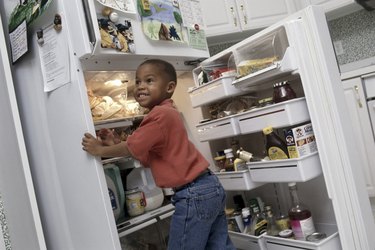
Of all the technologies modern life relies on, refrigeration may be the most important -- and the most overlooked. Modern refrigeration allows people to store food longer and move it farther than people could in the past, and refrigeration also made food-borne illness much less common. Before the advent of modern refrigeration, people used many other techniques to safely store perishable food and keep it edible.
Food Preservation Techniques
Video of the Day
The process of drying food in the sun existed as early as 12,000 B.C. Other methods of food preservation including curing food in salt and spices, smoking meats and fish, fermenting food underground and pickling it in acidic brine. Today, people dry fruits and vegetables and smoke-cure meats to create jerky.
Video of the Day
Ancient Food Cooling
Early methods of cooling food to preserve it included freezing food in lakes during winter, keeping food in cool caves or cellars and submerging it in cold streams. Early Egyptians cooled water by placing it in earthen jars on the roof overnight, exposing it to cool night air. Ancient people also used ice houses -- insulated buildings that kept snow and ice from melting -- to preserve and cool food and drinks, even in warm climates. Stephanie Dalley, a historian retired from Oxford University, where she specialized in Assyriology, writes that early Mesopotamian civilizations harvested ice and stored it in ice houses as early as 1780 B.C. Other writings suggest that ancient Chinese, Greek, Roman, and Hebrew civilizations buried snow and ice in storage pits and covered it with insulators such as sawdust or straw. They then used the snow or ice to cool drinks or to keep food fresh.
Ice Boxes and Cold Pantries
By the late 1800s, many Americans used more practical ice boxes instead of ice houses to keep food cool. An ice box is similar to a modern refrigerator in many ways, but instead of producing its own cold air, it used a large block of ice to keep food cool. Ice men delivered this ice every day in insulated ice trucks. Because the cold space in ice boxes was small, many homes in temperate climates also used cold pantries, or California coolers, to keep canned and pickled food cool.
Modern Refrigerators
Inventors started to build refrigerators as early as the 1830s, but it took a long time for the devices to catch on commercially. Brewers were the first businesses to use mechanical refrigeration regularly, and refrigerated brewing was common by the 1890s. Meat-packing companies also began to use refrigeration to preserve meat in the late 1800s, and it was commonplace by 1914. Household refrigerators were invented in the 1880s, but didn't become a fixture in American homes until the 1920s. By 1950, 80 percent of rural American homes and 90 percent of urban houses had a refrigerator in the kitchen.